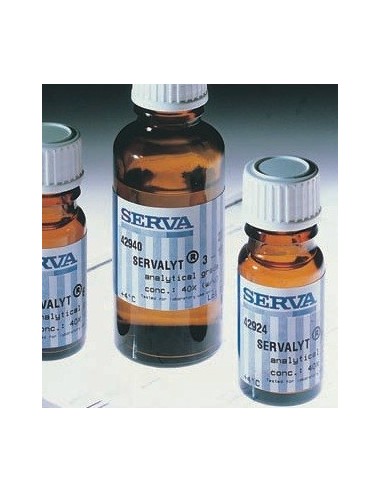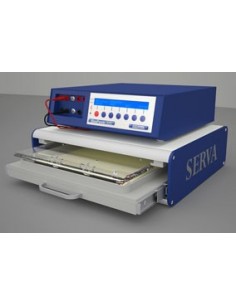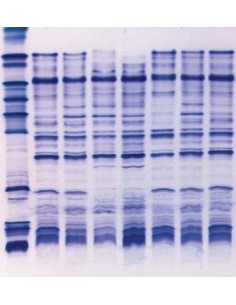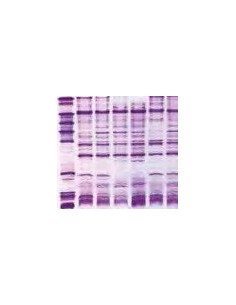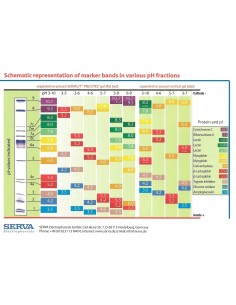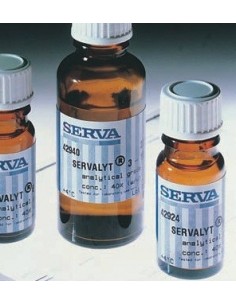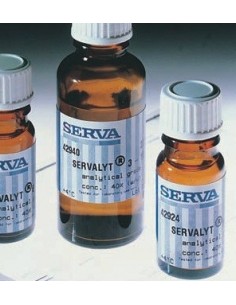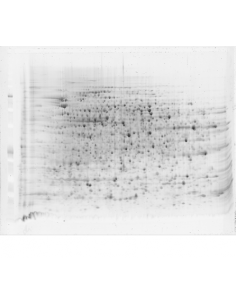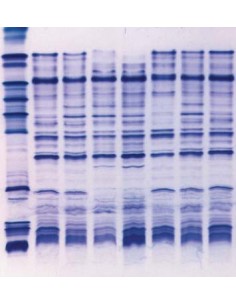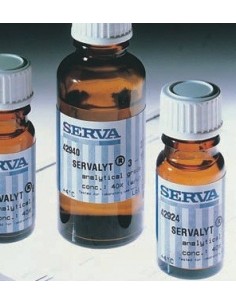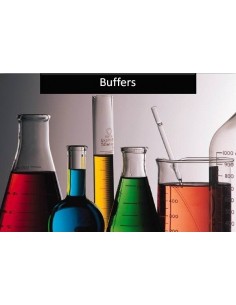Ampholytes 4-7 (Servalyt 4-7)
Carrier ampholyte 4-7
Applications: Isoelectric focusing, capillary electrophoresis, free-flow electrophoresis
SERVALYT 4-7 carrier ampholytes are useful in identifying acidic isotypes in purified protein samples such as monoclonal antibodies or other biosimilar protein products.
Supplied as 40 % aqueous concentrate and sterile filtered (0.2 μm). If stored at 4 °C and unopened shelf is up to 3 years. The common working concentration is in the range of 3 % to 5 %. Excellent for high resolution of acidic protein in isoelectric focusing (IEF), capillary isoelectric focusing (cIEF) and free flow electrophoresis applications.
Benefits:
- High Resolution
- Widest Range Available
- Fast Staining and Clear Background
- Ready to Use or Blending
- 3 year shelf life
Comparison of different brands of carrier ampholytes
Using an ampholyte pH 4-7 in isoelectric focusing (IEF) offers several applications and benefits, including:
Broad range of protein separation: The pH range of 4-7 covers a wide spectrum of isoelectric points (pI) for proteins. It allows for the separation of proteins with slightly acidic, neutral, and slightly basic characteristics. This broad range enables the analysis of diverse protein samples and subsets.
Comprehensive analysis of protein mixtures: IEF using an ampholyte pH 4-7 enables the separation and analysis of complex protein mixtures. It can resolve proteins with different pI values within the pH range of 4-7, facilitating the detection and identification of individual components in a mixture. This is particularly valuable in proteomics research and biomarker discovery studies.
Enhanced resolution and accuracy: The use of an ampholyte pH 4-7 in IEF improves the resolution and accuracy of protein separation. The establishment of a pH gradient within this range allows proteins to migrate and focus at their respective pI positions, resulting in well-resolved protein bands. This enhances the sensitivity and specificity of protein analysis and characterization.
Identification of protein isoforms and modifications: Many proteins exist in multiple isoforms or undergo post-translational modifications, leading to variations in their pI values. Using an ampholyte pH 4-7 in IEF enables the separation and identification of these protein isoforms and modified forms. This allows researchers to study protein heterogeneity, functional implications of isoforms, and the impact of modifications on protein behavior.
Protein purification and enrichment: IEF using an ampholyte pH 4-7 can be utilized for protein purification and enrichment. By focusing on the pH range of 4-7, proteins of interest can be separated from other contaminants or unwanted proteins. This facilitates the isolation of specific proteins for downstream applications, such as further analysis or functional studies.
Comparative analysis of protein expression: IEF with an ampholyte pH 4-7 allows for the comparative analysis of protein expression patterns between different samples. By comparing the protein profiles, researchers can identify differences in protein expression levels or isoform distribution, providing insights into cellular processes, disease mechanisms, and biomarker discovery.
Integration with other techniques: IEF using an ampholyte pH 4-7 can be integrated with other techniques for comprehensive protein analysis. Following the separation in the first dimension, the resolved proteins can be further analyzed using techniques such as gel electrophoresis, Western blotting, or mass spectrometry, enabling a multi-dimensional approach for protein characterization.
In summary, using an ampholyte pH 4-7 in IEF offers a broad range of protein separation, comprehensive analysis of protein mixtures, enhanced resolution and accuracy, identification of protein isoforms and modifications, protein purification and enrichment capabilities, comparative analysis of protein expression, and integration with other techniques. These benefits make it a valuable tool in various areas of protein research, including proteomics, biomarker discovery, and protein characterization.
No reviews

